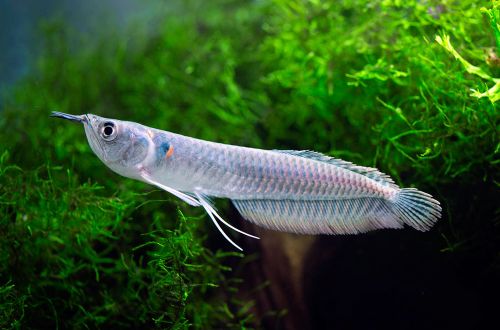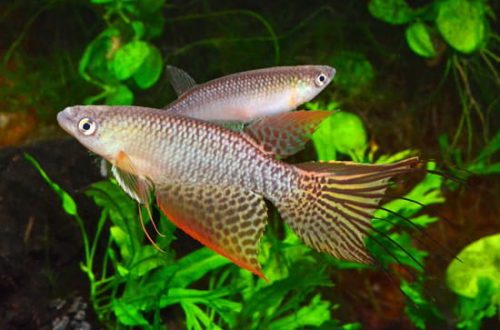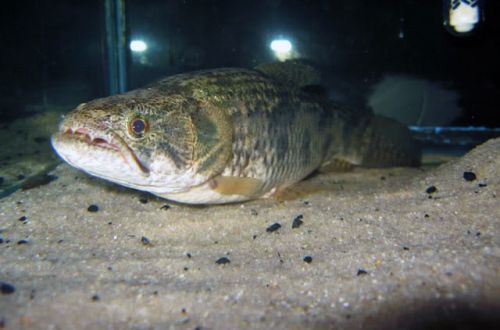
Aravan
Aravana or Silver Aravana, scientific name Osteoglossum bicirrhosum, belongs to the Osteoglossidae family. Representative of one of the oldest families of fish preserved from the Jurassic period (150 million years). They also inhabited the rivers of the super-continent Gondwana, which broke up into South America, Africa, Australia and Southeast Asia. That is why the related species Aravana is found on all these continents.

The fish is considered difficult to keep due to its size and diet. Recommended only for experienced aquarists (and probably the wealthy). Fry are often found on sale at a very affordable price. However, not everyone thinks about the problems that an adult fish can cause. Therefore, as they grow, they are often disposed of.
Brief information:
- The volume of the aquarium – from 1000 liters.
- Temperature – 20-30°C
- Value pH — 5.0–7.5
- Water hardness – soft to medium hard (2-15 dGH)
- Substrate type – any
- Lighting – subdued, moderate
- Brackish water – no
- Water movement – light or moderate
- The size of the fish is up to 80 cm.
- Food – meat or live food
- Temperament – territorial, aggressive
Contents
Habitat
It comes from South America from most of the Amazon basin with its many tributaries. During the dry season, it prefers slow-moving regions, backwaters and lagoons. During the rainy season, it swims to flooded areas of tropical forests.
Description
Adult individuals reach a length of 70–80 cm. The body is elongated, the dorsal and anal fins stretch from the middle of the body to the very tail, forming a single “fan”. Such a structure provides a quick acceleration of the fish in the process of hunting and the ability to carry out high jumps. The main feature is the structure of the mouth, which opens up to capture prey from the surface. On the lower jaw there are two bone processes, which are reflected in the scientific name of this fish. Osteoglossum – from Greek can be translated as “bone tongue”.
Food
A predator, although plant components are also present in the diet – fruits and other fruits of trees. In the wild, it hunts for fish and insects, and not only aquatic ones. Aravana is able to look out for prey that is above the water, for example, on leaves or a tree trunk, then she makes a jump and catches her prey with amazing accuracy. The basis of the diet in a home aquarium can be shrimp, mussels without shells, earthworms, various insects, as well as pieces of fish meat, or live.
Maintenance and care, arrangement of the aquarium
Aravan can only be kept in very large and high tanks from 1000 liters with efficient filtration systems and other special equipment. The aquarium is designed as a biotope close to its natural habitat with numerous large snags, a bottom covered with leaves, overhanging vegetation and several floating plants.
Such aquariums are expensive and are usually installed and maintained by professional craftsmen, and the owners just enjoy the result. Therefore, this article does not provide detailed information about the features of keeping this species of fish.
Behavior and Compatibility
In nature, Aravans adhere to a distinct hierarchy, when the dominant individual controls a certain area and does not allow other relatives to go to it. For this reason, when keeping 2 or more fish, fierce skirmishes can occur between them.
Joint keeping is only possible with species of comparable size that will not be considered prey, such as Pacu or large Amazonian catfish. It is necessary to exclude fish that live in the upper layers of the water in order to avoid possible conflicts over the territory.
Breeding / breeding
During the breeding season, an adult female lays 50 to 250 eggs. However, brood size rarely exceeds 12–30 fry. Juveniles are quite large, reaching a length of up to 7 cm. It is at this age that they are often on sale.
Breeding Aravana in a home aquarium is rare and involves many difficulties. This task is done much more effectively on commercial fish farms.
Fish diseases
Hardy and unpretentious fish that does not have diseases characteristic of this type. The most probable causes of possible diseases are in the content area: poor water quality with high concentrations of hazardous substances (products of the nitrogen cycle), unsuitable pH and dGH parameters, etc. For more information on symptoms and treatment methods, see the Aquarium Fish Diseases section.





